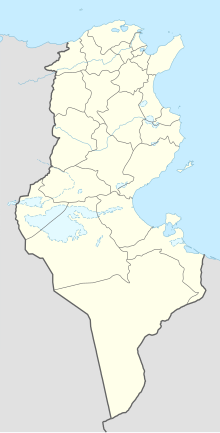Utica (Tunisia)
Coordinates: 37 ° 3 '24 " N , 10 ° 3' 44" E
Utica is a historic city in what is now Tunisia . According to the Roman historian Velleius Paterculus, it was built around 1100 BC. Founded in BC, it was considered the oldest Phoenician city in North Africa in ancient times .
founding
However, the archaeological finds in Utica date to the 8th century BC. BC to the 8th century AD. Since Gades, which was founded around the same time after Velleius Paterculus, no Phoenician settlement before approx. 800 BC Chr. Could be proven, the handed down very early date of foundation is extremely doubtful. The name "Utica" is the Latinized form of the Punic-Phoenician ˁattiq , which means "the old (city)".
Carthaginian time
Utica was at the mouth of the Bagrada (now Medjerda) in what is now Tunisia. The cemeteries stretch on either side of the watercourse that served as a port. Soon the city expanded inland.
The city always held a special position among the vassals of Carthage . In the first treaty of Carthage with Rome from 508 BC Utica does not occur. That could mean that it was still completely independent at the time. In the second treaty with Rome from 348 BC Utica is mentioned next to Carthage. When Agathocles advanced from Syracuse to Africa, he was able to 308 BC. Take Utica and thereby temporarily isolate Carthage. In the mercenary war , it was captured by the renegade mercenaries, which was 240 BC. Led to the First Battle of Utica . The city remained loyal to the rebel cause even afterwards. When she finally submitted, she was not punished excessively.
Despite this temporary apostasy, Utica appears again as nominally equal in the treaty between Hannibal and Philip V of Macedonia in 215 BC. During the Second Punic War, Publius Cornelius Scipio besieged the city after landing in Africa and defeated the Carthaginian relief army. In the Third Punic War , Utica fell around 150 BC. From Carthage and fought on the side of Rome .
Roman time
In the Roman province of Africa , Utica had the status of a free city with certain privileges and was until 43 BC. BC under the name Municipium Julium Uticense provincial capital. In 46 BC Chr. There died Cato the Younger from suicide. Utica experienced a heyday in the 2nd century AD.
The port silted up in the 3rd century - the mouth of the Medjerda River is now a good ten kilometers from the former city - and Utica gradually fell into disrepair. Eventually the Vandals 439 and 534 the Byzantines conquered the city. After the conquest by the Arabs (around 683) the settlement was finally abandoned.
The titular diocese of Utica goes back to this city.
present
The museum on the site of the ruins shows exhibits from the 8th to 5th centuries BC. BC, mainly grave goods , steles and urns from the Punic necropolis . These include amphorae, oil lamps, clay figures, imported goods from Egypt and vases from Greece. A special sight from Roman times is a Neptune's head with lobster claws in curly hair, surrounded by sea creatures and boats, in the museum garden.
Web links
Tunisian-British excavation project Utica
literature
- Walter Hatto Gross : Utica. In: The Little Pauly (KlP). Volume 5, Stuttgart 1975, Sp. 1081 f.
- BH Warmington: Carthage. The rise and fall of a world power . Title of the original English edition: Carthago . Robert Hale Ltd., London 1960. Translation from English by Paul Baudisch. FA Brockhaus, Wiesbaden 1964
Notes and individual references
- ↑ Velleius Paterculus, Historia Romana 1,2: 80 years after the Trojan War , whose end in antiquity mostly in the early 12th century BC. . AD was dated.
- ↑ Nabil Kallala et al .: Survey and excavation at Utica, 2010. p. 1
- ^ Velleius Paterculus, Historia Romana 1,2.
- ^ Sebastián Celestino, Carolina López-Ruiz: Tartessos and the Phoenicians in Iberia. Oxford University Press, 2016, pp. 140 f.



